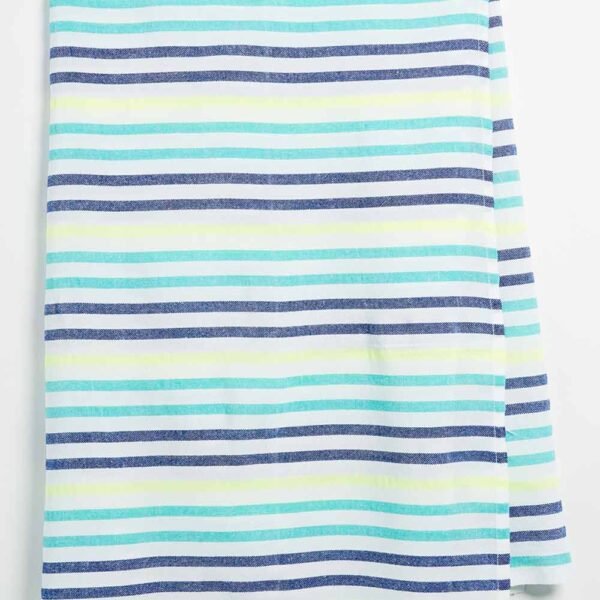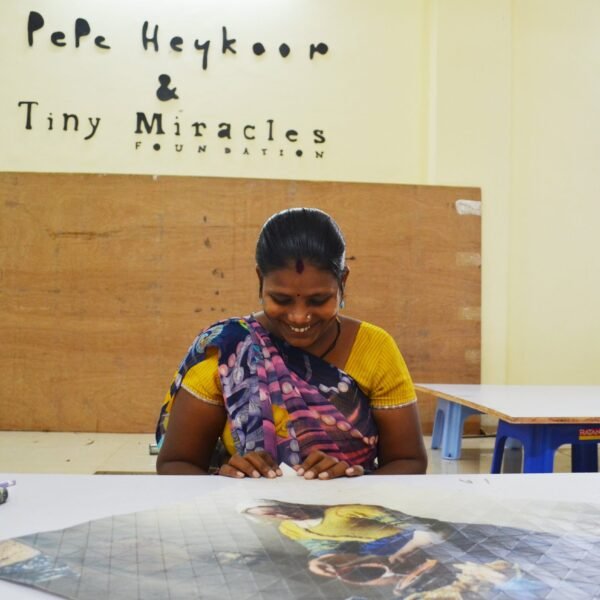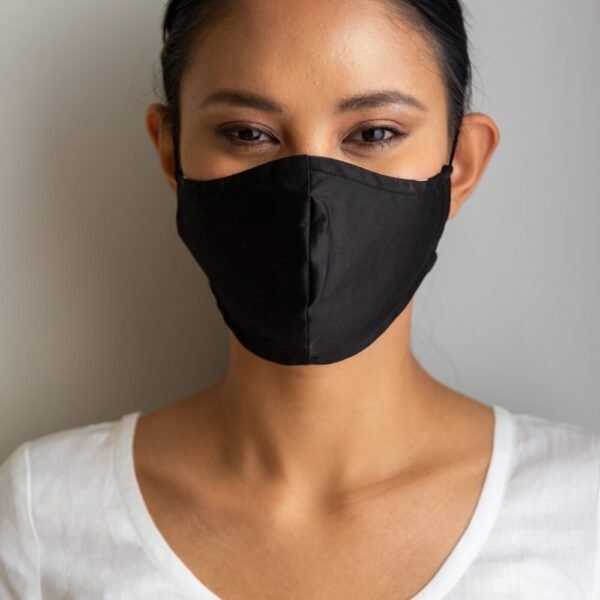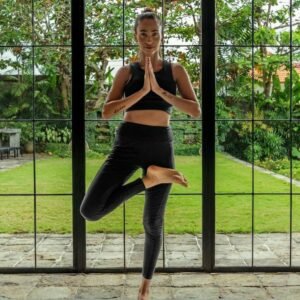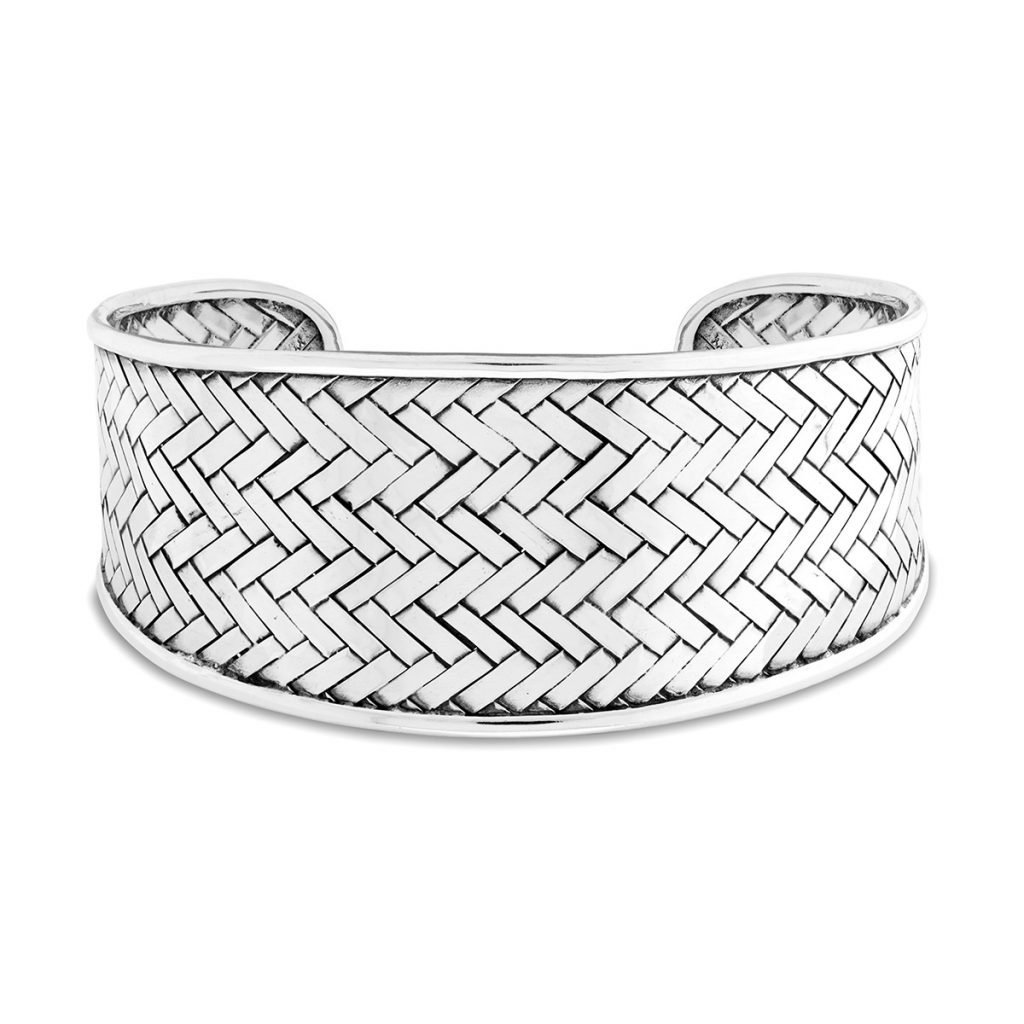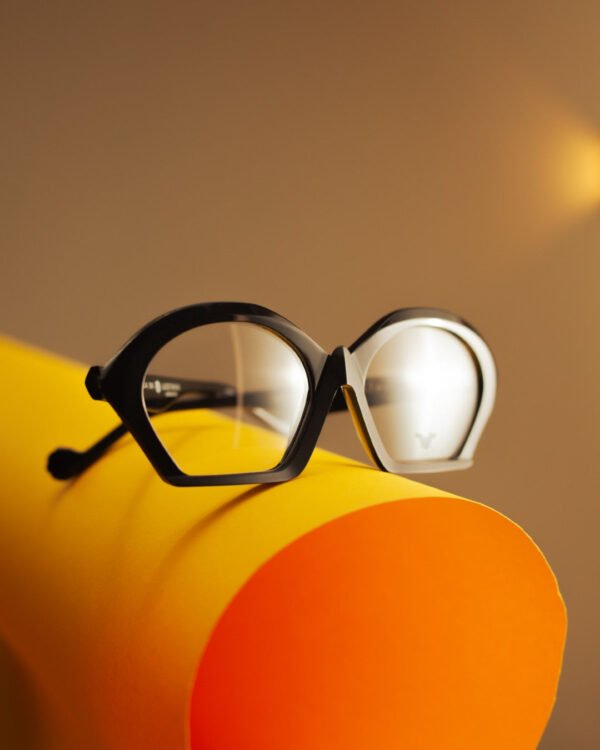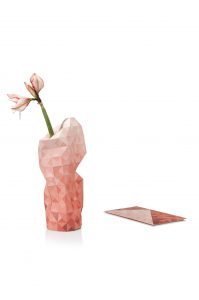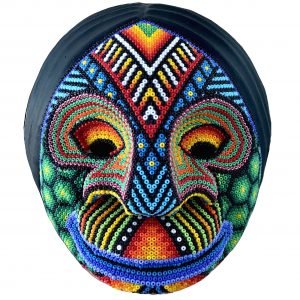
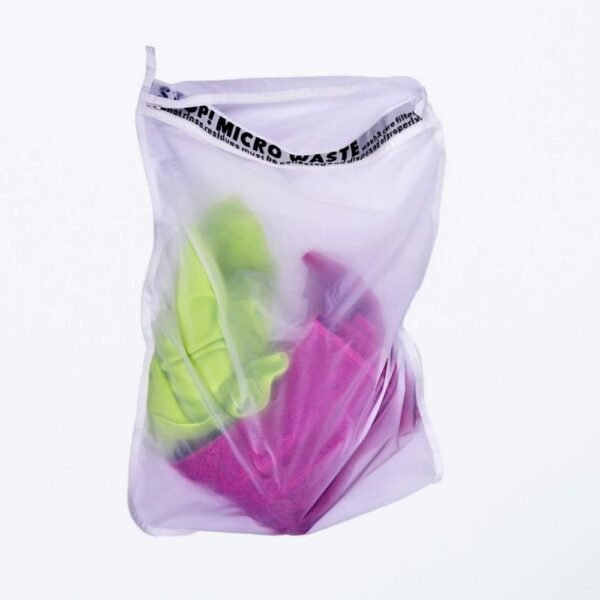
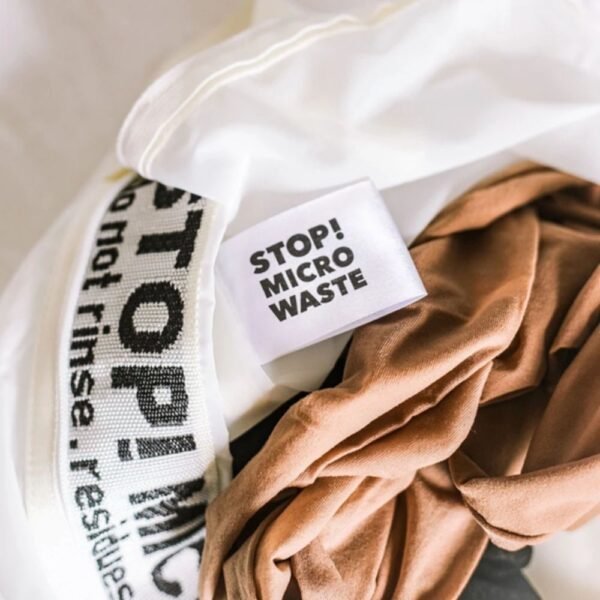
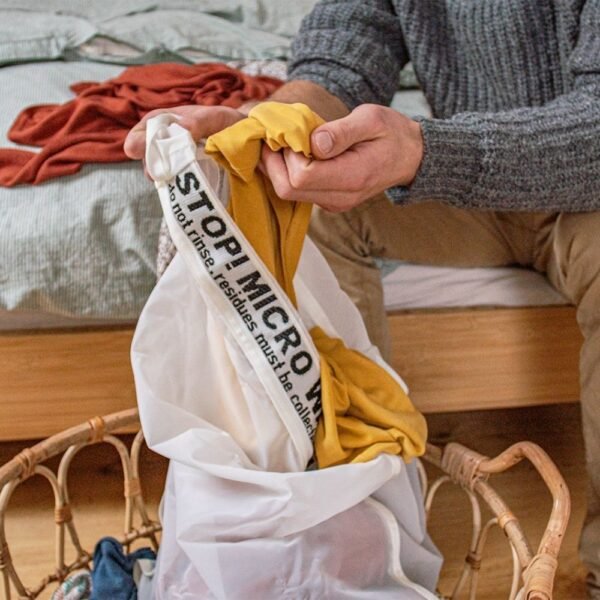
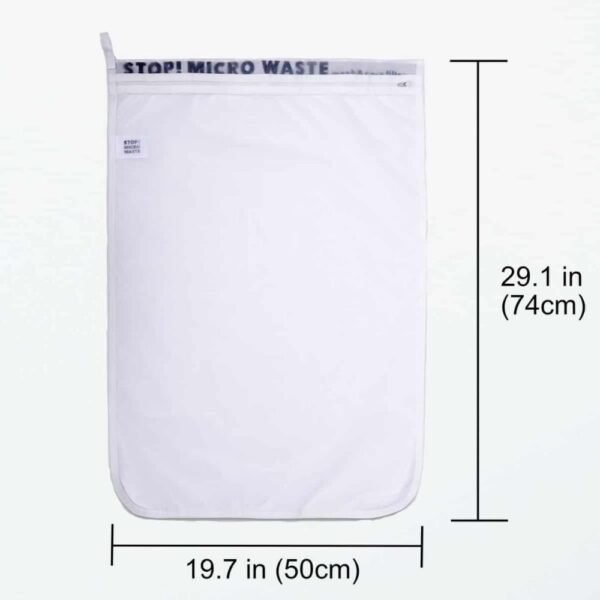





Guppybag- Washing bag
- AED: 175.00AED
- GBP: $35.29
- AUD: $74.07
- KWD: $14.667
- EUR: €42.14
- CAD: $65.83
- OMR: $18.260
- QAR: $172.58
- SAR: $177.85
- SGD: $61.34
- ZAR: $853.27
The Guppyfriend Washing Bag aka Guppybag is an effective, scientifically proven, and patented solution to stop microplastic pollution. It reduces fiber shedding and protects our clothes. It filters the microfibres that do break and doesn’t lose any fibers themselves.
We are aware we need to change our buying habits and washing rituals and the Guppybag is the first pragmatic solution. It prevents microplastic fibers from entering rivers and oceans through the washing of synthetic textiles. The broken fibers will stay in the corners of the washing bag after washing and can be easily removed and disposed of.
- Material: untreated polyamide 6.6
- Size M: 50 x 74 cm
- With multilingual packaging and instructions
- 100% plastic-free packaging

Guppybag- Washing bag
- AED: 175.00AED
- GBP: $35.29
- AUD: $74.07
- KWD: $14.667
- EUR: €42.14
- CAD: $65.83
- OMR: $18.260
- QAR: $172.58
- SAR: $177.85
- SGD: $61.34
- ZAR: $853.27
Description
The Guppyfriend Washing Bag aka Guppybag is an effective, scientifically proven, and patented solution to stop microplastic pollution. It reduces fiber shedding and protects our clothes. It filters the microfibres that do break and doesn’t lose any fibers themselves.
We are aware we need to change our buying habits and washing rituals and the Guppybag is the first pragmatic solution. It prevents microplastic fibers from entering rivers and oceans through the washing of synthetic textiles. The broken fibers will stay in the corners of the washing bag after washing and can be easily removed and disposed of.
Read MoreIt is well known that microplastic released from washing harms the environment. With each wash, countless microfibres from synthetic textiles make their way from washing machines into rivers, lakes, and oceans. Once in the environment, the microfibres concentrate bacteria and pollutants. They are consumed by aquatic organisms, which can result in gastrointestinal infections and blockages, reproductive problems, and starvation. Serious consequences are not limited to animals and nature. The tiny plastic fragments threaten our own health: They enter our food and our bodies through the food chain.
A large part of our clothing contains synthetic materials. During washing, tiny plastic fibers break and enter rivers and oceans via the wastewater and thus harm our environment. This is exactly where the Cora Ball and the Guppyfriend washing bag come in. According to the Fraunhofer Institute UMSICHT, on average 86% fewer fibers of synthetic clothing break when washed with the washing bag.
- Material: untreated polyamide 6.6
- Size M: 50 x 74 cm
- With multilingual packaging and instructions
- 100% plastic-free packaging
How to use your Guppybag
- Put synthetic textiles into the Guppyfriend washing bag.
- Fill to about ⅔ full so that the textiles can easily move around in the bag.
- Close the Guppyfriend washing bag and put it in the washing machine. Add other non-synthetic textiles to the load outside the bag and wash as usual.
- We recommend wash at 40°c maximum. Use liquid and natural detergents without synthetics if possible.
- Take your clothes from the Guppyfriend washing bag while they’re still wet.
- Remove the collected fibers from the inside of the filter fabric by hand and dispose of them in the residual waste.
Also, please:
- Do not rinse the bag under running water – so that the collected microplastic fibers are not washed into the environment.
- Don’t wash sharp-edged objects with your Guppy bag.
- Guppybag doesn’t need ironing. Ironing can damage the material. Do not mind the crumpled surface.
- Don’t use it in the tumble dryer. The broken fibers can get out of the bag.
- Avoid hang/dry in direct sunlight. It can damage the bag.
https://youtu.be/26tyzk3sFBs
Some questions you might have about Guppybag
What material is the Guppyfriend Washing Bag made of?
Apart from the zip, the Guppyfriend Washing Bag is made entirely of polyamide 6.6. The material is untreated, undyed, and contains no additives. The fabric is made of monofilaments. These are more like sticks than threads and do not lose any fibers themselves.
Why doesn’t the Guppyfriend itself shed any microplastics?
The Guppyfriend Washing Bags are made of polyamide 6.6. This is a high-tech material and is particularly tough and resistant to alkalis. The fabric itself doesn’t shed any microplastic fibers because it is made of monofilaments.
These are more like stable sticks than threads, which are made from several fibers and are typically used for textiles. The binding tape consists of long-staple fibers. Even if these should become detached from the bond, it is unlikely that they will break off.
How big are the microfibres that break off during washing? Why can the Guppyfriend Washing Bag even catch fibers that are smaller than its openings?
During the washing process, all garments lose fibers. The fibers break from the structure of the fabric due to mechanical stress and abrasion. The broken fibers are typically 50 µm to 15 mm long and usually no thicker than 10 µm. 1µm = 0.001 mm or about 0.000039 inch. They could theoretically slip through the small openings of the Guppyfriend Washing Bag. But they do not.
To get through the opening, the fiber would have to poke vertically through the fabric. However, due to the water in and around the bag and the movement, the fibers are never positioned vertically, but always slightly bent. Therefore, they cannot pierce through the mesh. Even if a fiber should stick out of the fabric, it will be pushed back into the bag.
What sizes are available?
At the moment we offer the Guppyfriend Washing Bag in the standard size M, which is 50 x 74 cm. According to our tests, the Medium bag is the most effective size for household use. In a larger bag, more microfibres would break off due to the greater friction. For larger amounts of laundry, it, therefore, makes sense to use two medium bags instead of one large one.
In addition, there should still be enough space in the laundry drum to wash a few loose (non-synthetic) laundry items in addition to the Guppyfriend. This will prevent any possible imbalance. As soon as other sizes are available we will inform you on our website and social media channels.
EVIDENCE
Who tested the Guppyfriend Washing Bag and what were the results?
The Guppyfriend Washing Bag was tested over a period of three years by scientific institutes, universities, representatives of the outdoor and textile industry, as well as retailers. These tests serve as a basis for offering the Guppyfriend Washing Bag as a temporary solution against microplastic pollution. In particular, we have tested with the following scientific and independent institutes:
- German Textile Research Centre North-West, DTNW
- Fraunhofer Institute UMSICHT
- University of California at Santa Barbara as part of the Patagonia research program.
Results said that the Guppyfriend Washing Bag prevents fiber loss during washing in two ways:
1. The Guppyfriend Washing Bag drastically reduces the number of fibers that break off.
Tests by the Fraunhofer Institute UMSICHT showed an average:
a) 79% with partly synthetic clothes
b) 86% with completely synthetic clothing. Thus, the clothing can be worn much longer.
2. Plastic fibers that break off during washing are retained in the bag and thus do not pollute the wastewater. The fibers were retained by over 90% – in most cases 100% – in all tests. Nanoparticles, mostly residues from production, which can be found especially on cheap textiles, cannot be retained by the washing bag.
Other test results:
- No toxic residues were found on the product.
- The bags can withstand 50 household washes according to ISO 6330 without damage and do not release any microplastic particles into the water themselves (Note: when used correctly, the Guppyfriend Washing Bag can also be used beyond the tested number of 50 washes).
- Cleanliness after washing: Blood, ketchup, and chocolate are washed out without any problems. The washing effect of skin grease and clay is sufficient.
- The number of broken fibers depends on the washing conditions and the clothes themselves.
In summary:
The Guppyfriend Washing Bag significantly reduces fiber breakage. The fibers that break off during washing are retained in the bag. The clothes become clean and – if the wash bag is used correctly – it can be used for a long time to keep microplastics out of our rivers and oceans.
What are the profits from the Guppyfriend Washing Bag sales used for?
The profits from the sale of the Guppyfriend Washing Bag go to the NGO STOP! MicroWaste and enable the realization of the STOP! Plastic Academy. In the “Train the Trainer” program of the STOP! Plastic Academy we do workshops for partners, consumers, and educational institutions to raise awareness on (micro)plastic pollution.
MORE ABOUT THE USE
- What clothes belong in the Guppyfriend Washing Bag?
- The Guppybag helps reduce the amount of microplastic fibres entering the environment. These break off, for example, when washing synthetic textiles (polyester, acrylic, nylon, etc.). It therefore makes sense to wash particularly these textiles in the Guppyfriend. Fleece jackets, sportswear and outdoor clothing are often made entirely or to a large extent of synthetic fibres, but most other garments also contain a certain amount of synthetics.
You can check the care label to see what your garments are made of.However, clothes made of pure cotton and wool can also be washed in the Guppyfriend Washing Bag, because textiles made of natural materials also lose fibres.
Washing in the Guppyfriend significantly reduces fibre breakage and thus protects your clothes from wear and tear. You can enjoy your clothes much longer – another sustainable advantage of the Guppyfriend Washing Bag.
By the way: Unfortunately, synthetic fibres may even be present in clothes if they are not indicated on the care label. The rules for listing the components on care labels vary widely, thus a jumper labelled as 100% wool may contain up to 10% of synthetic fibres.
- What is the best detergent to use with the Guppyfriend Washing Bag?
- To protect your clothes and for a good wash result, we recommend using a liquid detergent, ideally made from natural ingredients. Washing powders often contain abrasive particles that cause more fiber breakage and can leave deposits on your laundry. But whether you use washing powder or liquid detergent, in both cases it is important to pay attention to the dosage.
Too much detergent damages your clothes and the environment. Only natural detergents without synthetics, such as abrasive particles, gel, gums and silicones, opacifiers, acrylates, and cross-polymers are not problematic. If you use washing powder, please make sure that it does not contain any liquid plastics or rubbers (xanthan gum) or abrasive particles and that the detergent is well dissolved before it gets onto the laundry.
Since liquid detergent is mainly sold in plastic packaging, you can also fill your own liquid detergent in many zero-waste shops, which of course improves the eco-balance even more.
By the way: The Guppyfriend also works with washing eggs or washing nuts. However, any solid object washed with the clothes will cause significantly more fibers to break. We can therefore not recommend the use of a wash egg or wash nuts – even if they are used with good intentions – as they lead to more plastic in the oceans.
- At what temperatures can I wash the washing bag?
- In our tests, the Guppyfriend was washed at a maximum temperature of 40°C. Therefore, we do not recommend washing hotter than 40°. In general, the warmer you wash, the shorter the life of your clothes.
- Why is my laundry still wet when it comes out of the washing machine? How can I avoid an imbalance?
- When washing with the Guppyfriend Washing Bag, an imbalance can occur during the spin cycle. To prevent damage to the washing machine, the spin cycle is often automatically stopped or the speed reduced. This can result in your laundry coming out of the washing machine very wet. To avoid this, it is important to always put additional garments without any synthetic fibers into the washing drum when using the Guppyfriend washing bag. You can also add another filled washing bag. This prevents an imbalance and your washing machine should spin as usual.
- Can the Guppyfriend Washing Bag be put in the tumble dryer?
- No. During the drying process, just what is not supposed to happen happens: Due to static charging, the broken microfibres pierce through the bag and end up in the laundry drum and ultimately in the environment. The reason for this is that the electrostatic reaction of round plastic material (such as synthetic clothing and the round nylon monofilaments of the Guppyfriend laundry bag) creates a magnetic field. Broken fibers are attracted and orientate themselves at a 90° angle to the mesh of the Guppyfriend Washing Bag. Aligned in this way, they can pierce the material and go straight through the mesh. In the washing machine, there is water in and around the bag and the broken fibers lie at various angles on the net, so they cannot pierce through it.
- How do I properly dispose of the collected microfibres?
- Please dispose of the collected microfibres in the residual waste. It is best to collect and dispose of the collected fibers in a closed container. This reduces the chance of the small and very light synthetic fibers being blown away during waste collection and ending up in the environment. Microfibres do not belong to recyclable waste because they cannot be recycled.
I can hardly find any fibers in the bag. What am I doing wrong?
It’s perfectly normal if you don’t find any microfibres at first. They are very small and often transparent, so they are sometimes difficult to find with the naked eye, especially in a wet bag. In addition, the Guppyfriend Washing Bag has been designed to prevent microfibre loss at the source.
Due to the smooth surface and structure of the material, fewer microfibres break off during washing. This ensures that your clothes are protected, pilling is avoided and fiber loss is reduced.
According to a test series by the Fraunhofer Institute UMSICHT, synthetic clothing loses on average 86% fewer fibers compared to washing without the Guppyfriend Washing Bag. The microfibres that nevertheless break off accumulate over time. You are most likely to find them in the corners or at the hem.
- By the way: The number of fibers that break during washing depends on the type of clothes and the way you wash them: very new or very old clothes tend to lose more microfibres. The higher the temperature, the more likely it is that microfibres will break off. The softer the fabrics, the fewer fibers will break off, etc.
How often can the Guppyfriend Washing Bag be used?
The Guppyfriend Washing Bag withstood the 50 washes of our tests flawlessly. However, if you follow our instructions for use, you can use your bag for many more wash cycles. After a few washes, the washing bag won’t look new, but it will still do its job perfectly.
- How do I dispose of my washing bag?
- The Guppyfriend Washing Bag is made of untreated polyamide 6.6 and is designed to be completely recyclable when you remove the zip. The best thing to do is to dispose of it in the recycling bin and thus introduce it into the recycling system. To do this, separate the cover with the zipper from the fabric. In Germany, the fabric belongs in the yellow bin (yellow bag, green dot) and the zipper in the residual waste. By the way: Recycled material cannot (yet) be used for high-tech fabrics like the material of our Guppyfriend Washing Bags. Unfortunately, old Guppyfriends cannot yet be used for the production of new Guppyfriends. Therefore, it does not make sense to return your old Guppyfriend to us – especially with regard to the resources needed for shipping. It is best to return your old Guppyfriend to your local recycling center, where it can be recycled with identical materials.
Why isn’t there a microplastic filter installed directly in the washing machine?
- Microfibres are so small that they would immediately clog permanently installed filters, quite literally in a matter of seconds. The microfibres that collect on the filter would be forced through the filter into the wastewater due to the high water pressure. To avoid this, the filter would have to be constantly replaced or cleaned.We have developed a working prototype for a washing machine filter and other companies are also working on such solutions.
- However, it will take some time before these filters are effective and permanently functional. Until then, the Guppyfriend Washing Bag is a practical and effective way to reduce plastic pollution in rivers and oceans and raise awareness about the problem.
- Why can’t sewage treatment plants filter microplastics efficiently?
- Washing machines are usually unable to filter out the microplastic fibers in our textiles that break off during washing. Thus, the fibers enter the sewage treatment plants with household wastewater. However, countless particles escape the filter systems and end up in our environment. According to a study by the University of California in Santa Barbara, on average 60% – 99% of microplastic particles are filtered out of the water.
In Germany, only 20 out of about 10,000 sewage treatment plants have the so-called purification stage 4, whose main aim is to rid our wastewater of medicine residues. Microplastic fibers are particularly difficult to filter out. Due to their shape and floating properties, they pass through the filter systems much more frequently than other types of microplastics such as pellets, so-called microbeads from cosmetics, and other plastic fragments.
But even if they are filtered out, the plastic particles often end up back in the environment with the sewage sludge. If the sewage sludge is not incinerated, it is used as fertilizer on fields. From here, the microplastic particles bound in the sewage sludge make their way back into our oceans.
So-called combined sewer overflows are another problem. They serve to relieve the sewage system in the case of heavy rain. In order to prevent backwater in households during heavy rainfall, the wastewater flows through the sewers untreated when the volume of water is high.
By the way, the wastewater from the gullies does not pass through a sewage treatment plant but flows mostly unfiltered into our waters. The microplastic particles from tire and shoe sole abrasion, as well as microplastic fibers found in the air and in sewage sludge, therefore pollute our environment directly.
For technical reasons, the filtering possibilities of sewage treatment plants are unfortunately not sufficient to prevent the pollution of the oceans by microplastics. However, by rethinking our buying habits and mindful washing behavior, everyone can contribute to reducing the number of microplastics entering the environment.
Additional information
| Country of origin | U.S. |
|---|---|
| Materials | Untreated Polyamide 6.6 |
| Size | M: 50 x 74 cm |
| Color |
Related products
Henry Toilet Bag
- AED: 350.00AED
- GBP: $70.58
- AUD: $148.14
- KWD: $29.335
- EUR: €84.28
- CAD: $131.67
- OMR: $36.519
- QAR: $345.17
- SAR: $355.70
- SGD: $122.69
- ZAR: $1,706.53
In Stock
La Alicia Beach Blanket
- AED: 150.00AED
- GBP: $30.25
- AUD: $63.49
- KWD: $12.572
- EUR: €36.12
- CAD: $56.43
- OMR: $15.651
- QAR: $147.93
- SAR: $152.44
- SGD: $52.58
- ZAR: $731.37
In Stock
Alpaca Miniature Figure
- AED: 250.00AED
- GBP: $50.42
- AUD: $105.81
- KWD: $20.953
- EUR: €60.20
- CAD: $94.05
- OMR: $26.085
- QAR: $246.55
- SAR: $254.07
- SGD: $87.64
- ZAR: $1,218.95
In Stock
Red Gradient Paper Vase Cover by Pepe Heykoop
- AED: 100.00AED
- GBP: $20.17
- AUD: $42.32
- KWD: $8.381
- EUR: €24.08
- CAD: $37.62
- OMR: $10.434
- QAR: $98.62
- SAR: $101.63
- SGD: $35.05
- ZAR: $487.58
In Stock
You may also like
Branded Logo Fabric Face Mask- Only Available for UAE
- AED: 40.00AED
- GBP: $8.07
- AUD: $16.93
- KWD: $3.353
- EUR: €9.63
- CAD: $15.05
- OMR: $4.174
- QAR: $39.45
- SAR: $40.65
- SGD: $14.02
- ZAR: $195.03
In Stock
Fast Fashion is not free – Organic Cotton T-shirt
- AED: 125.00AED
- GBP: $25.21
- AUD: $52.91
- KWD: $10.477
- EUR: €30.10
- CAD: $47.02
- OMR: $13.043
- QAR: $123.27
- SAR: $127.04
- SGD: $43.82
- ZAR: $609.48
In Stock




